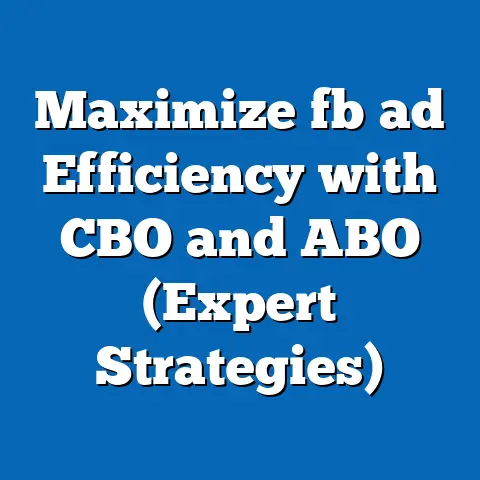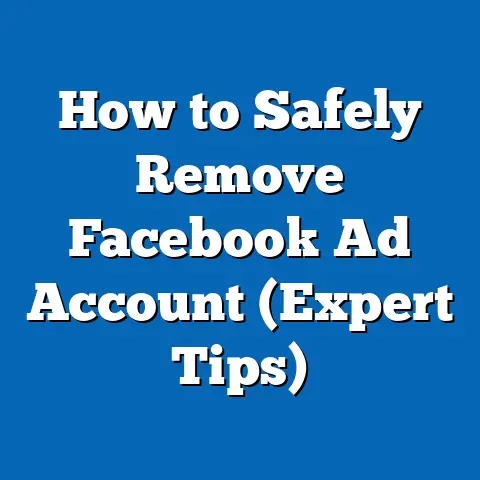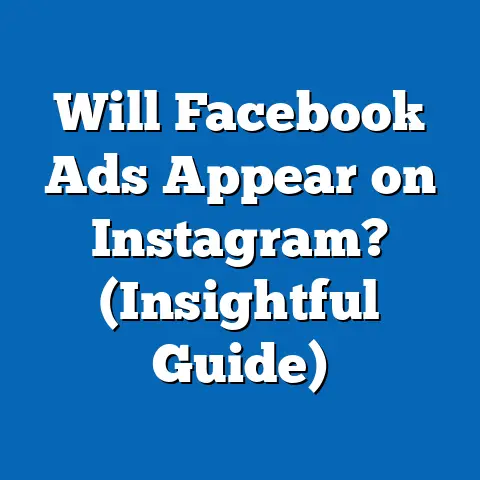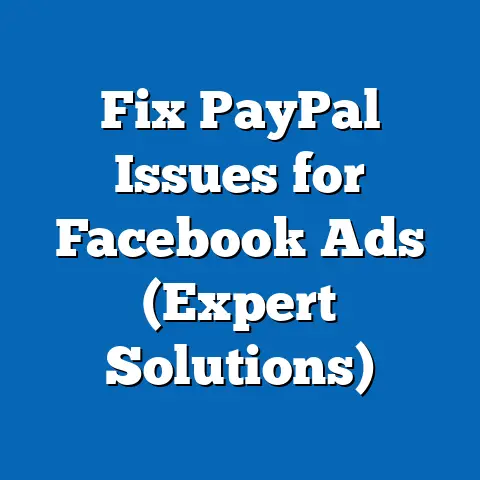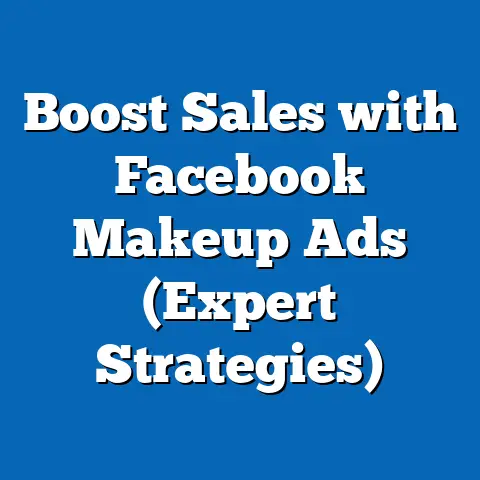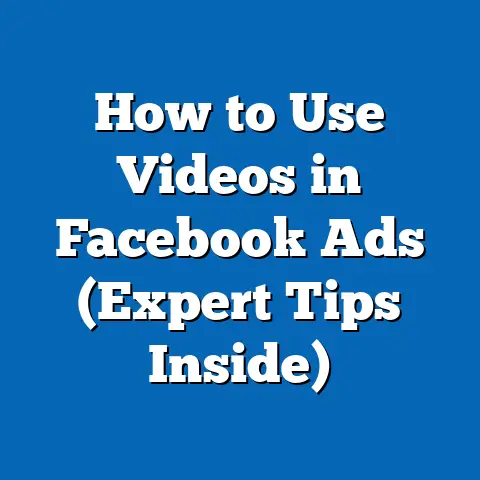Revamp Offensive Facebook Ads (Engagement Strategies Unlocked)
Let’s face it: running Facebook ads can feel like walking a tightrope. You’re constantly trying to balance grabbing attention with staying relevant, and sometimes, things go wrong. I’ve seen it firsthand – ads that fall flat, or worse, ads that actively offend your target audience. Nobody wants that. The sting of negative comments, the plummeting engagement rates, and the feeling that your marketing budget is just vanishing into thin air… it’s a frustrating experience.
The truth is, many businesses struggle to create Facebook ads that truly resonate. They end up with ads that are perceived as irrelevant, out-of-touch, or even offensive. This isn’t just a matter of poor taste; it directly impacts your ROI and brand image. In today’s hyper-sensitive social media landscape, one misstep can lead to a viral backlash and lasting damage to your reputation.
That’s why it’s crucial to address this issue head-on. It’s not enough to simply create ads; you need to ensure they’re connecting with your audience in a positive, meaningful way. That’s why I want to help you transform those underperforming or problematic ads into powerful tools for audience connection and brand promotion.
In this article, I’m going to dive deep into innovative engagement strategies that can help you revamp your offensive Facebook ads. We’ll explore the root causes of offensive advertising, the importance of understanding your audience, and the techniques you can use to craft positive messages and captivating visuals. By the end, you’ll have a clear roadmap for creating Facebook ads that not only avoid offense but also drive genuine engagement and build lasting relationships with your customers.
Understanding the Roots of Offensive Ads
Before we jump into solutions, let’s first understand what makes an ad “offensive” in the eyes of the Facebook audience. It’s not always about blatant hate speech or discriminatory content. Often, it’s the subtle missteps, the unintentional oversights, and the failure to consider the diverse perspectives of your target audience that lead to negative perceptions.
An “offensive” Facebook ad can be anything that triggers a negative emotional response, alienates a segment of your audience, or contradicts their values. Here are some common elements that contribute to this:
- Insensitivity to Cultural Issues: This includes cultural appropriation, stereotyping, or ignoring social issues that are important to your audience. I remember once seeing an ad that used a traditional Native American headdress as a fashion statement. The backlash was swift and severe, with many people calling out the brand for its cultural insensitivity.
- Overly Aggressive Sales Tactics: Nobody likes to feel pressured or manipulated. Ads that are too pushy, use deceptive language, or make unrealistic promises can come across as offensive and damage your credibility. Think of those “limited-time offer” countdown timers that never actually expire.
- Misleading Content: False or exaggerated claims, clickbait headlines, and deceptive visuals are a surefire way to offend your audience. Honesty and transparency are crucial for building trust and fostering positive engagement.
- Lack of Relevance: Showing ads to people who have no interest in your product or service can be annoying and perceived as a waste of their time. This is especially true if the ad is intrusive or irrelevant to their interests.
- Tone-Deaf Messaging: This occurs when your ad’s tone or message doesn’t align with current events or social sentiments. For example, running a lighthearted, humorous ad campaign during a time of national crisis can be seen as insensitive and offensive.
The psychological impact of offensive advertising can be significant. Studies have shown that negative experiences with ads can lead to:
- Decreased Brand Trust: People are less likely to trust brands that they perceive as offensive or insensitive.
- Negative Word-of-Mouth: Consumers are more likely to share negative experiences with ads than positive ones, leading to a viral backlash.
- Decreased Purchase Intent: Offensive ads can deter potential customers from buying your products or services.
- Damage to Brand Reputation: A single offensive ad can have a lasting impact on your brand’s image and credibility.
Take, for example, the case of a major beverage company that ran an ad featuring a black woman being pulled over by police. The ad was intended to be a commentary on racial inequality, but it was widely criticized for being tone-deaf and insensitive to the experiences of black Americans. The company faced a massive boycott and had to pull the ad.
Key Takeaway: Understanding the root causes of offensive ads is the first step in preventing them. By being mindful of cultural sensitivities, avoiding aggressive sales tactics, and ensuring your ads are relevant and respectful, you can minimize the risk of alienating your audience and damaging your brand.
The Importance of Audience Research
The key to avoiding offensive ads lies in understanding your target audience. It’s not enough to simply know their age, gender, and location. You need to delve deeper into their values, beliefs, interests, and pain points. This is where audience research comes in.
Audience research is the process of gathering information about your target audience to understand their needs, preferences, and behaviors. This information can then be used to inform your ad content and ensure it resonates positively with your intended audience.
Here’s how demographic, psychographic, and behavioral data can inform your ad content:
- Demographic Data: This includes age, gender, location, income, education, and occupation. This data can help you tailor your ad content to specific groups of people. For example, if you’re targeting young adults, you might use a more casual tone and feature trendy visuals.
- Psychographic Data: This includes values, beliefs, interests, lifestyle, and personality. This data can help you understand what motivates your audience and what they care about. For example, if you’re targeting environmentally conscious consumers, you might highlight your company’s sustainability efforts.
- Behavioral Data: This includes past purchases, website visits, social media activity, and engagement with your ads. This data can help you understand how your audience interacts with your brand and what types of ads they’re most likely to respond to. For example, if you’re retargeting website visitors who abandoned their shopping carts, you might offer them a discount to encourage them to complete their purchase.
There are several methods you can use to conduct audience research effectively:
- Surveys: Surveys are a great way to gather direct feedback from your target audience. You can use online survey tools like SurveyMonkey or Google Forms to create and distribute surveys.
- Social Media Listening Tools: Social media listening tools like Mention or Brandwatch can help you track conversations about your brand, your industry, and your competitors. This can give you valuable insights into what people are saying about your brand and what they care about.
- A/B Testing: A/B testing involves creating two versions of an ad and testing them against each other to see which performs better. This can help you identify what types of messages and visuals resonate most with your audience.
- Facebook Audience Insights: Facebook Audience Insights is a free tool that provides data about the demographics, interests, and behaviors of people on Facebook. This can be a valuable resource for understanding your target audience.
Creating customer personas is another essential step in understanding your audience. A customer persona is a fictional representation of your ideal customer, based on your audience research. Customer personas help you visualize your target audience and understand their needs, motivations, and pain points.
For example, let’s say you’re selling organic skincare products. Your customer persona might be “Eco-Conscious Emily,” a 30-year-old woman who is passionate about sustainability and healthy living. She values natural ingredients, ethical sourcing, and cruelty-free products. By understanding Emily’s values and priorities, you can create ads that resonate with her and encourage her to purchase your products.
Key Takeaway: Audience research is the foundation of effective Facebook advertising. By understanding your target audience, you can create ads that are relevant, engaging, and respectful, minimizing the risk of offense and maximizing your ROI.
Crafting a Positive Message
Once you have a solid understanding of your target audience, you can start crafting a positive message that resonates with them. This involves choosing the right tone, language, and imagery to convey your brand’s values and connect with your audience on an emotional level.
Here’s a framework for developing ad copy that is inclusive, relatable, and engaging:
- Focus on Benefits, Not Features: Instead of simply listing the features of your product or service, focus on the benefits it provides to your customers. How will it make their lives easier, better, or more enjoyable?
- Use Inclusive Language: Avoid using language that is gendered, biased, or exclusionary. Use inclusive language that welcomes and respects all members of your audience.
- Be Authentic and Transparent: Honesty and transparency are crucial for building trust. Be upfront about your company’s values and practices, and avoid making false or misleading claims.
- Speak to Your Audience’s Pain Points: Identify the challenges and frustrations that your audience faces, and show them how your product or service can help them overcome those challenges.
- Use a Positive and Uplifting Tone: Avoid using negative or fear-based messaging. Focus on creating a positive and uplifting tone that inspires and motivates your audience.
Let’s look at some examples of successful Facebook ads that exemplify positive messaging and engagement:
- Dove’s Real Beauty Campaign: Dove’s Real Beauty campaign is a classic example of positive messaging. The campaign features real women of all shapes, sizes, and ethnicities, challenging traditional beauty standards and promoting body positivity.
- Nike’s Dream Crazy Campaign: Nike’s Dream Crazy campaign features athletes who have overcome adversity to achieve their dreams. The campaign celebrates diversity, inclusion, and the power of sport to inspire change.
- Airbnb’s Belong Anywhere Campaign: Airbnb’s Belong Anywhere campaign promotes the idea of travel as a way to connect with people from different cultures and backgrounds. The campaign fosters a sense of community and belonging.
What makes these ads work? They all share several key characteristics:
- They’re Authentic: They’re true to the brand’s values and mission.
- They’re Relevant: They speak to the audience’s needs and interests.
- They’re Emotional: They evoke positive emotions and create a connection with the audience.
- They’re Inclusive: They welcome and respect all members of the audience.
Storytelling is another powerful tool you can use in ad creation. Narratives can create an emotional connection with your audience and foster engagement. When you tell a story, you’re not just selling a product or service; you’re sharing an experience, a perspective, or a message that resonates with your audience on a deeper level.
For example, instead of simply advertising your coffee shop, you could tell the story of how you started your business, the challenges you faced, and the passion that drives you to serve your community. This can help you connect with your audience on a more personal level and build a stronger relationship with them.
Key Takeaway: Crafting a positive message is essential for creating Facebook ads that resonate with your audience and avoid offense. By focusing on benefits, using inclusive language, being authentic and transparent, and leveraging storytelling, you can create ads that connect with your audience on an emotional level and build lasting relationships.
Leveraging Visuals and Design
Visuals play a crucial role in Facebook ads. They’re often the first thing people see, and they can either enhance or detract from your message. That’s why it’s important to choose visuals that align with your brand, resonate with your audience, and avoid potentially offensive content.
Here are some best practices for selecting images, colors, and fonts for your Facebook ads:
- Choose High-Quality Images: Use images that are clear, well-lit, and visually appealing. Avoid using grainy, blurry, or pixelated images.
- Use Relevant Images: Choose images that are relevant to your product or service and your target audience. Avoid using stock photos that look generic or staged.
- Use Diverse Images: Feature people of different races, ethnicities, genders, and abilities in your images. This shows that your brand is inclusive and welcomes all members of your audience.
- Use Brand-Consistent Colors: Use colors that align with your brand’s identity and evoke the desired emotions. Avoid using colors that are jarring, clashing, or overwhelming.
- Use Readable Fonts: Choose fonts that are easy to read and that align with your brand’s personality. Avoid using fonts that are too small, too decorative, or too difficult to decipher.
Let’s look at some case studies of brands that successfully revamped their visuals to increase engagement and mitigate negative feedback:
- Aerie’s #AerieREAL Campaign: Aerie, American Eagle’s lingerie sub-brand, launched the #AerieREAL campaign, which features unretouched photos of models of all shapes and sizes. The campaign was praised for its body positivity and authenticity, and it led to a significant increase in sales and brand loyalty.
- Always’ #LikeAGirl Campaign: Always’ #LikeAGirl campaign challenges the stereotype that doing something “like a girl” is weak or inferior. The campaign features girls and women doing amazing things, and it empowers them to embrace their strength and confidence.
- Pantene’s #SeeBeautyNotGender Campaign: Pantene’s #SeeBeautyNotGender campaign challenges gender stereotypes in the workplace. The campaign features transgender and gender-nonconforming individuals, and it promotes diversity and inclusion.
These campaigns all have one thing in common: they use visuals to challenge stereotypes, promote diversity, and celebrate individuality. They show that brands can use visuals to make a positive impact on society and build stronger relationships with their customers.
Key Takeaway: Visuals are a powerful tool for conveying your brand’s message and connecting with your audience. By choosing high-quality, relevant, and diverse images, using brand-consistent colors, and selecting readable fonts, you can create Facebook ads that are visually appealing, engaging, and inclusive.
Implementing Engagement Strategies
Now that you have a positive message and captivating visuals, it’s time to implement engagement strategies that will help you connect with your audience on a deeper level. This involves using techniques that encourage interaction, foster community, and build lasting relationships.
Here are some actionable strategies for improving engagement with your revamped ads:
- Interactive Content: Use interactive content like polls, quizzes, and contests to encourage your audience to participate and share their opinions. This can help you gather valuable feedback and learn more about their preferences.
- User-Generated Content: Encourage your audience to create and share content related to your brand. This can help you build a sense of community and foster authenticity. For example, you could ask your customers to share photos of themselves using your products or services.
- Personalized Targeting: Use Facebook’s targeting options to reach the right people with the right message. This ensures that your ads are relevant and engaging to your target audience.
- Retargeting: Retarget people who have previously interacted with your brand, such as website visitors or email subscribers. This can help you re-engage them and encourage them to take action.
- Segmentation: Segment your audience based on their interests, behaviors, and demographics. This allows you to create ads that are tailored to specific groups of people.
- Timing and Frequency: Experiment with different ad schedules to find the optimal timing and frequency for your ads. This helps you maximize visibility and minimize annoyance.
Retargeting and segmentation are particularly important for ensuring that your ads reach the right people with the right message. Retargeting allows you to re-engage people who have already shown an interest in your brand, while segmentation allows you to tailor your ads to specific groups of people based on their characteristics.
For example, let’s say you’re running a Facebook ad campaign for a new fitness program. You could retarget website visitors who viewed the program’s landing page but didn’t sign up. You could also segment your audience based on their fitness goals, such as weight loss, muscle gain, or improved endurance. This allows you to create ads that are tailored to each group’s specific needs and interests.
Key Takeaway: Implementing engagement strategies is crucial for creating Facebook ads that connect with your audience on a deeper level. By using interactive content, user-generated content, personalized targeting, retargeting, and segmentation, you can create ads that are relevant, engaging, and effective.
Conclusion
Revamping offensive Facebook ads is not just about avoiding negative feedback; it’s about creating a positive, meaningful connection with your audience. It’s about building trust, fostering community, and driving genuine engagement.
As we’ve discussed, this involves several key steps:
- Understanding the roots of offensive ads: Being mindful of cultural sensitivities, avoiding aggressive sales tactics, and ensuring your ads are relevant and respectful.
- Conducting thorough audience research: Understanding your target audience’s values, beliefs, interests, and pain points.
- Crafting a positive message: Using inclusive language, being authentic and transparent, and leveraging storytelling.
- Leveraging visuals and design: Choosing high-quality, relevant, and diverse images, using brand-consistent colors, and selecting readable fonts.
- Implementing engagement strategies: Using interactive content, user-generated content, personalized targeting, retargeting, and segmentation.
It’s time to take action and improve your ad campaigns. Start by reviewing your existing ads and identifying any potential areas of concern. Conduct thorough audience research to gain a deeper understanding of your target audience. Craft positive messages and captivating visuals that resonate with their values and interests. And finally, implement engagement strategies that encourage interaction and build lasting relationships.
By taking these steps, you can transform your offensive Facebook ads into effective tools for audience connection and brand promotion. You can create ads that not only avoid offense but also drive genuine engagement, build lasting relationships with your customers, and ultimately, achieve your marketing goals. Don’t just advertise; connect!

